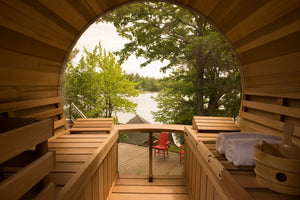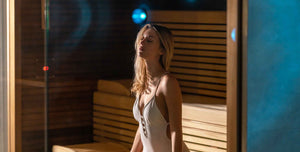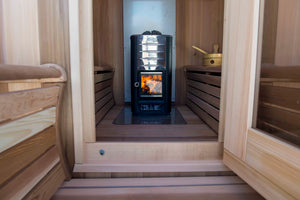Large outdoor saunas have become increasingly popular for homeowners who want to enjoy the benefits of sauna bathing while making it a social experience. These spacious structures can comfortably accommodate 6-8 people or more, offering a perfect setting for relaxation and socialization.
A large outdoor sauna provides ample space for multiple users while creating a dedicated wellness sanctuary in your backyard. Built with high-quality materials like Nordic Spruce, today's large outdoor saunas combine traditional sauna benefits with modern design elements. Many come as DIY kits that make installation straightforward, while allowing customization to match your specific needs and outdoor setting. With proper planning, a large outdoor sauna can become the centerpiece of your home wellness routine and outdoor entertainment space.
Types of Outdoor Saunas
Outdoor saunas come in several varieties, each offering unique benefits and heating methods. The design, materials, and heating technology can dramatically affect your sauna experience.
Traditional Sauna
Traditional outdoor saunas use heated rocks to produce steam and warm the air, typically reaching temperatures between 150-195°F with relatively low humidity. Water is poured over the heated rocks to create löyly (steam), which increases humidity and enhances heat transfer.
Traditional saunas are often built from weather-resistant woods like cedar, pine, or thermowood. These materials naturally resist decay and withstand outdoor conditions.
The heating system usually consists of:
-
Wood-burning stove (most authentic)
-
Electric heater (more convenient)
-
Gas heater (less common)
Traditional saunas require a warm-up period of 30-45 minutes. This longer heating time is part of the ritual that many sauna enthusiasts appreciate. The dry heat followed by bursts of steam creates a deeply relaxing experience.
Finnish Sauna
Finnish saunas represent the original sauna tradition with roots dating back thousands of years in Nordic culture. These saunas feature a distinctively hot, dry environment initially, with temperatures ranging from 175-230°F. Finnish outdoor saunas are often constructed in a simple rectangular shape or the popular barrel design. Barrel saunas heat more efficiently due to their curved shape, which promotes natural air circulation.
Key features of Finnish saunas include:
-
Multi-level benches (heat varies by height)
-
Natural stone heaters
-
Essential ventilation systems
Finnish sauna sessions typically follow a pattern of heating, cooling (often by swimming in cold water or snow), and relaxation. This cycle may be repeated several times during a session. The practice promotes blood circulation and deep relaxation.
Infrared Sauna
Infrared saunas use advanced technology that directly heats your body rather than warming the air around you. They operate at lower temperatures (120-140°F) while providing similar benefits to traditional saunas. These saunas use infrared heaters that emit radiation absorbed directly by your skin. This creates a gentler experience that some find more comfortable than higher-temperature saunas.
Infrared saunas offer several practical advantages:
-
Quicker heating time (typically 10-15 minutes)
-
Lower energy consumption
-
Less humidity (better for sensitive electronics)
Infrared technology comes in three varieties: near, mid, and far infrared, each penetrating the body at different depths and offering unique therapeutic benefits. They’re available in pre-fabricated kits that are easier to install than traditional models. There are also various sizes, from single-person units to larger cabins that can accommodate groups.
Design and Materials
Choosing the right materials for your large outdoor sauna is crucial for longevity, performance, and appearance.
Hemlock Vs. Cedar
Western Red Cedar and Hemlock are ideal for outdoor saunas. Cedar naturally resists decay, repels insects, and withstands moisture without warping, plus its natural oils create that distinctive sauna aroma many enthusiasts love. Hemlock also offers excellent value with its lighter color and straight grain pattern. Though less aromatic than cedar, it's still durable and less expensive, making it ideal for budget-conscious builders.
Clear Western Red Cedar is perfect for bench tops where skin contact occurs, as it remains cooler to the touch than other woods. For structural elements where appearance is less important, Hemlock provides strength at a lower cost. Bear in mind that cedar will add 15-25% to your material costs, but offers superior longevity and that classic sauna scent.
Insulated Panels
Proper insulation is vital for any outdoor sauna. Insulated panels help maintain heat, reduce energy costs, and protect against external elements. Modern saunas often use specialized panels with reflective barriers that direct heat back into the sauna room. For outdoor installations, opt for R-13 to R-19 insulation values to ensure efficient heating and operation in various weather conditions. The walls, ceiling, and floor all require proper insulation to prevent heat loss.
Pre-fabricated insulated panels save significant construction time. These panels combine structural elements, insulation, and vapor barriers in one component. They're particularly useful for DIY builders wanting to simplify the construction process. Remember that proper vapor barriers must be installed between the insulation and the interior wood to prevent moisture damage over time.
Aesthetics and Durability
The natural oils in cedar create resistance to decay and insects, making it ideal for exterior cladding in various climates. For peak durability, treat exterior wood with a UV-resistant clear sealant that allows the natural wood grain to show while providing weather protection. Avoid paints or stains that seal the wood completely, as these can trap moisture.
The roof design significantly impacts both appearance and function. A curved roof optimizes air circulation while creating a distinctive appearance. This design also sheds snow and rain efficiently. Also, consider adding exterior features like covered changing areas or porches to enhance functionality and visual appeal. These elements extend the usable space and create a more complete outdoor sauna experience.
Sauna Installation and Accessories
Setting up your large outdoor sauna involves key components that affect functionality and comfort.
Control Panel Technology
Modern outdoor saunas feature advanced control panels that make operation simple and intuitive. Digital touchscreen controls allow precise temperature adjustments between 150-190°F, often including programmable timers so your sauna can be ready when you arrive home.
Many high-end models now offer smartphone connectivity, letting you start heating your sauna remotely. This feature is particularly valuable for outdoor installations where you don't want to wait in the cold. Look for control panels with built-in safety features like automatic shut-off after predetermined periods.
Sauna Seating Options
Comfortable seating dramatically enhances your sauna experience. Traditional benches made from Nordic pine or cedar provide natural comfort and durability in high heat.
For large outdoor saunas, consider tiered seating arrangements that:
-
Accommodate multiple users comfortably
-
Allow for different heat intensities (higher benches = more heat)
-
Provide options for sitting or reclining
Ergonomic backrests reduce strain during longer sessions, while removable bench sections make cleaning easier and extend the life of your sauna. Some manufacturers also offer customizable layouts to fit your specific space.
Heating Solutions
For large outdoor saunas, choose heaters rated between 6-12 kW, depending on your sauna's size and insulation quality. Electric heaters offer convenience with precise temperature control and minimal maintenance. Meanwhile, traditional wood-burning stoves create an authentic experience with pleasing aromas and sounds, but require more attention and ventilation.
Larger saunas benefit from:
-
Stone capacity of 50+ pounds for consistent heat retention
-
Multiple heating elements for even distribution
-
Proper insulation around the heater for safety
Installation should include appropriate ventilation to maintain air quality and humidity control. Consider heaters with separate controls for dry sauna versus steam settings to maximize versatility in your outdoor sanctuary.
Benefits and Considerations
Outdoor saunas offer numerous advantages for health and lifestyle while requiring thoughtful planning regarding placement and design.
Health and Relaxation
Regular sauna sessions help with detoxification as toxins leave your body through sweat. This natural cleansing process can leave you feeling refreshed and revitalized. The heat from saunas also improves circulation and dilates blood vessels, which can enhance cardiovascular health over time. After intense workouts, sauna time helps reduce muscle soreness and speeds up recovery.
Stress reduction is perhaps one of the most valuable benefits, as the quiet, peaceful environment allows for deep relaxation away from daily pressures. Many users report improved sleep quality following sauna sessions. Unlike indoor options, outdoor saunas often create a more authentic experience by connecting you with nature during your relaxation time.
Location and Environment
Proximity to your home should balance convenience with privacy. Place it close enough for easy access, especially during cold weather, but far enough to create a retreat-like feeling. The surrounding environment significantly impacts your experience, so position your sauna to take advantage of pleasant views while avoiding areas with excessive wind exposure.
Privacy elements like strategic landscaping, fencing, or natural barriers can enhance your sauna experience. Many outdoor sauna owners incorporate complementary features such as cold plunge pools, shower facilities, or relaxation decks to create a complete wellness zone.
Perhaps most crucial, consider utility connections early in your planning, as access to electricity is essential, while water proximity is beneficial for cooling down after sessions.
Get in touch to discuss the best sauna options for your needs, space, and budget.





